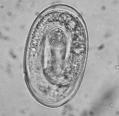Difference between revisions of "Dictyocaulus arnfieldi"
Jump to navigation
Jump to search
| Line 3: | Line 3: | ||
[[Image:Dictyocaulus arnfieldi.jpg|thumb|right|150px|''Dictyocaulus arnfieldi'' from horse faeces - Joaquim Castellà Veterinary Parasitology Universitat Autònoma de Barcelona]] | [[Image:Dictyocaulus arnfieldi.jpg|thumb|right|150px|''Dictyocaulus arnfieldi'' from horse faeces - Joaquim Castellà Veterinary Parasitology Universitat Autònoma de Barcelona]] | ||
| + | {{Taxobox | ||
| + | |name =''Dictyocaulus arnfieldi | ||
| + | |kingdom = | ||
| + | |phylum = | ||
| + | |class =Nematoda | ||
| + | |sub-class = | ||
| + | |order = | ||
| + | |super-family =Trichodectidae | ||
| + | |family = | ||
| + | |sub-family = | ||
| + | |genus =Dictyocaulus | ||
| + | |species ='''''D. arnfieldi''''' | ||
| + | }} | ||
{| cellpadding="10" cellspacing="0" border="1" | {| cellpadding="10" cellspacing="0" border="1" | ||
| Line 8: | Line 21: | ||
| '''Equine lungworm | | '''Equine lungworm | ||
|- | |- | ||
| − | |||
| − | |||
| − | |||
| − | |||
| − | |||
| − | |||
| − | |||
| − | |||
| − | |||
| − | |||
|} | |} | ||
Revision as of 12:40, 28 July 2010
| This article is still under construction. |
| Dictyocaulus arnfieldi | |
|---|---|
| Class | Nematoda |
| Super-family | Trichodectidae |
| Genus | Dictyocaulus |
| Species | D. arnfieldi |
| Also known as: | Equine lungworm |
Hosts
Donkeys, and occasionally horses.
Identification
Adults are slender, thread-like and white. Females are larger than males at around 6.5cm in length. The males have a small non-lobulated bursa.
The embryonated eggs are 80-100µm in length.
Life Cycle
The lifecycle is not greatly known, but it is currently thought to be similar to that of Dictyocaulus viviparus.
The prepatent period is 2-3 months.
